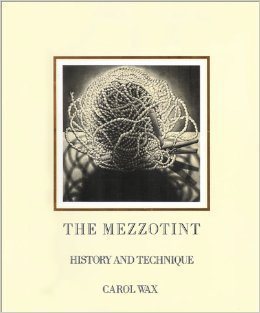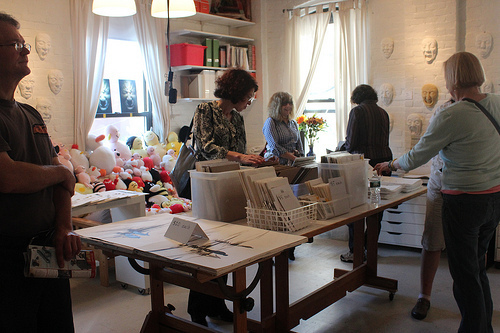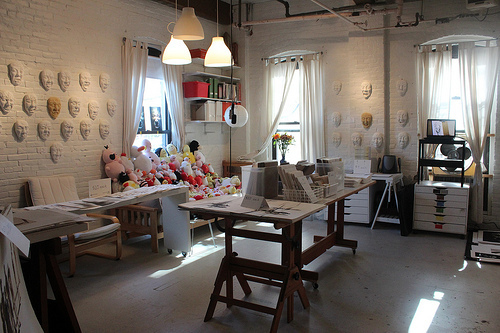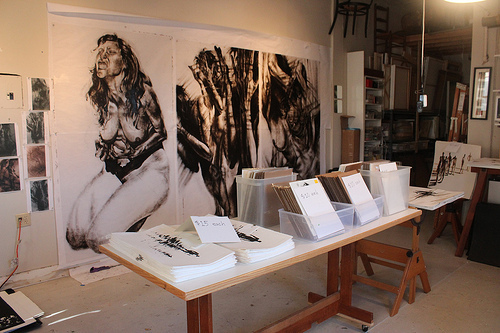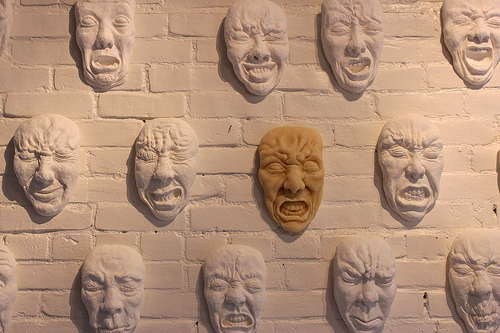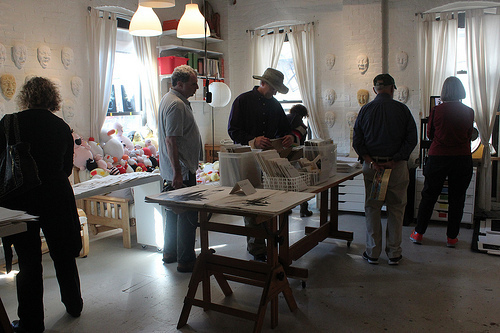Clara Lieu's Blog, page 41
November 9, 2013
Mezzotint research
I got to work on the etching ink stage of the latest drawing last night. Some of the pieces are taking almost a month to dry, so I think the plan is to work on my experimentation with mezzotint in the mean time.
I went to the RISD library yesterday and took out Carol Wax’s book “The Mezzotint, History and Technique”, the quintessential book written on mezzotint. It’s been fascinating to look at the images from history, and to get a sense of a technique that is seen so rarely. I guess that’s part of the reason why I’m interested, is that it’s such an obscure technique. The more I read about it, the more intimidated I feel by the rigorousness of the process. I ordered a prerocked plate this week, so I’ll experiment with that and see how it goes.


November 8, 2013
Follow Your Fear
This week I was asked to write a blog post for the TEDWeekends section of the Huffington Post. The blog post I wrote is in response to Alexa Meade’s TED talk “Your Body is My Canvas.” I had strong reservations about submitting what I wrote, as I discussed in this past blog post. Below is the post, please let me know what you think, I would love to get feedback.
Following your passion sounds like a no-brainer, but it is a path that is frequently full of intense fear and major risks. Fear is common for many artists, and is frequently a primary hurdle in the creative process. As an art student, I was so afraid of failure that I exclusively made artwork that was technically accomplished in order to guarantee “success.” I created paintings and drawings that were accurate and visually beautiful, but which were completely devoid of content and purpose. At the end of four years of study, I found myself with nothing but a bunch of pretty pictures.
I took the completely opposite approach with my current project: I followed my fear.
Three years ago, I was diagnosed with depression and anxiety. Having lived with this condition since age 10, undiagnosed, I found myself so deeply buried in the emotions of depression that I had no sense of self. When I received the diagnosis, it was an incredible shock to see myself clearly, free from the disease for the first time in my entire life. After treatment, I realized I had an extraordinary narrative that I could express through my artwork, but I had deep reservations about telling my story. Doing so meant publicly revealing my history with mental illness, which even in today’s world carries a heavy stigma.
I had never felt this strongly about a subject before, and I knew that I was on the verge of something tremendous. I knew the only way I wanted to represent the subject was directly, depicting the visual brutality of depression through the vehicle of the human face. I imagined Falling, a series of fifty self-portrait drawings, drawn hyper-realistically as a means of heightening the savage reality of depression. As I conceived the project in my head, I realized that I couldn’t ignore the idea. The only way to relieve this fierce compulsion was to make the artwork.
I am now three years into this project, and the fear that I experienced at the beginning has never really subsided. In fact, it seems like my fears have only increased as the project travels further out into the world and is seen by a wider audience. Most people are afraid to talk to me about the subject matter of my artwork, and I’ve noticed that my conversations at my exhibitions are limited to technical questions about my art materials. Instead, I’ve received moving emails from people sharing their experience with me, describing how much my artwork affected them. I’ve had students of mine approach me privately in order to reveal their struggles. Never before have I witnessed my artwork stimulate such a dramatic emotional response from my audience. Many people have told me that Falling is my best work to date.
In order to realize your passion, you have to be willing to embrace fear and take the necessary risks. Now, I see fear as the ultimate signal that I’m headed in the right direction. I intentionally assign tasks to myself that initially feel insurmountable and intimidating. In the case of Falling, it was the gargantuan task of creating 50 4′ x 3′ drawings, a quantity of artwork that I had never even come close to in my previous projects.
Every semester I tell my students that their artwork should never be easy, convenient, or manageable. I encourage my students to test their limits. I ask them to empower themselves by harnessing their fear as motivation to create their artwork. Recognize your fears, confront them head on, and use them as an impetus to drive your work forward. In this way your passion will be realized.


November 7, 2013
Who is this work for?
My experience at Waltham Mills Open Studios, and the blog post I wrote for the Huffington Post’s TEDWeekends this week has gotten me ruminating obsessively about why I’m making this work, and who the work is for.
I see my artwork from Falling as being as unpopular as art gets. The combination of the work being figurative, drawn in black and white in a realistic manner, and the disturbing subject matter makes the work toxic for most people. I feel that I am making artwork that no one wants to go near. There was an article in the New York Times about photographer David Jay’s project about breast cancer called “The Scar Project.” I found these images more riveting than any article I could read about breast cancer because they say “this is what breast cancer looks like.” The images are incredibly difficult to look at, which is what I think makes them so powerful. I think in some ways I’m trying to do something similar with depression.
David Jay, The Scar Project
Ideally, I see this work as belonging in a museum. I think in a museum people are more likely to accept being challenged by an artwork than they would be at a commercial gallery. I also accept that these works will likely never sell.
I wonder if part of the reason why I’m making these images is to increase awareness of mental illness. As a young adult, I had no idea what depression was. I didn’t know that you could seek treatment and support for the kinds of emotions that I was feeling, which is why I lived without a diagnosis for over twenty years. It hurts to think about all of those years, and I constantly wonder how different my life would have been had I received treatment from the beginning.
It seems to me that there are basically two reactions to the work: 1) people who are shocked by the images and say nothing and 2) people whose lives have been affected by mental illness, who come to me privately to express what an impact my work had on them. Am I only making the work for the latter audience? Are they the only ones who are willing to go near this work?
Who do you think this work is for?


November 6, 2013
Artist Masterclass: Solidity
Artist Masterclass is a series of conversations between myself and visual artist Sara Bloem.
CL: Last time we talked you had mentioned that things were settling in, and that you had developed a routine for working on your artwork. What kind of routines have you created and how did you arrive at them?
SB: I have developed a routine of working on this project every single day after work. I’ll typically come home, make dinner, and then work on this project. That can mean a lot of things – writing, generating ideas, doing research, or reading critical theory. The routine is held together by my keeping track of how much time I spend on what in a Notepad file on my phone. During the spring semester, I noticed that keeping track of my time in this way really held me accountable, so I’ve been keeping on with that.
CL: Many years ago when I used to have a paper calendar, I used to give myself little colored dots for accomplishing different tasks daily. Yellow for going to the gym, red for artwork, and green for practicing oboe. It was very silly, but I enjoyed getting to watch all of the dots accumulate on my calendar. It’s funny how these little things hold us together.
SB: Yeah, the human mind can be so trainable.
CL: I know you’re still in the brainstorming phase, where are you currently?
SB: I’m getting to the part where I have vague ideas about what imagery I want to work with. I’ve spent a lot of time soaking in the work of artists who’ve explored similar themes, so now it’s time to move on. I’ve looked at Ed Purver, Bora Baskan, Aleksandra Waliszewska, Rembrandt, Odd Nerdrum, Michael Mazur, you, and Louise Bourgeois.
(above) Images from a Locked Ward, by Michael Mazur
CL: I just took my RISD Freshman Drawing class to the Yale university art gallery print room and we saw these intaglio prints by Michael Mazur that were to die for. They were from his series called “Images from a Locked Ward.” If you haven’t seen them, definitely look them up. I was drooling the whole time. Did I ever tell you my Michael Mazur story?
SB: I don’t think so!
CL: I was at an opening reception for a printmaking exhibition that I was in, and I was standing around a group of people. This older man started talking, he mentioned that he liked my work and then went on this really long spiel about printmaking. I was thinking “Who is this guy?!?” After he left, I asked my colleague whether that man was a professor at the school, and she looked at me and said, “Honey, that was Michael Mazur!” Lesson: always find out whose hand you’re shaking.
So what imagery are you thinking of? What themes are you exploring with these images?
SB: I think it will be female figures in domestic settings trying on clothes. My primary theme, as always, is how cultures come together and apart. I was actually thinking for a while about whether my series would be more about the together or the apart, and I’ve decided to focus definitely on the former, since that is what I see happening around me much more.
CL: What is it that you see?
SB: I guess cultures melting together. The clothes will be from a range of eras – from the modern era, where we live, to colonial Indonesia, which has been my primary area of historical interest for a long time. I feel that showing people trying on clothes will give me a lot of concrete details to work with, but it will also speak to the idea of trying on different personas, and how people’s identities are layered as well generally.
CL: That sounds really solid, I know you were having a bit of an existential crisis last time we talked. Has the crisis subsided?
SB: I’m actually really excited, it feels like I’ve got something concrete to work with at last. Last time we talked, you said that a little bit of effort every day would pay off eventually. That is really happening right now. My rule is that I can’t go to sleep without getting something down on paper.
CL: A student of mine once wrote “If I don’t put it down on paper I’ll never know what might have happened.”
SB: Patience, and kind of obsessing about it when you’re doing other things.
CL: I know what you mean, I’ve been pretty obsessive myself lately. I just had open studios this past weekend and it really got me thinking about how my work is received. I’m feeling kind of compulsive about it, it’s all I can think about.
SB: That’s kind of a great feeling, isn’t it?
CL: It is and it isn’t; I’m trying to figure out who my art is for. People are clearly very afraid and intimidated by the images I’m making. They either say nothing or they make some comment on the technique and the materials. This is interesting: I had one person come back to my studio at the end of the day, to talk to me about his own experience with mental illness. He was very sensitive and told me how much he was affected by my artwork.
SB: Wow. That’s pretty flattering. And telling. You know, the work you’re making right now is clearly very strong. You can’t feel just neutral about it. I think that’s always good. Bland is the worst.
CL: I guess one of the reasons I’m doing this project with you is because I’m just really interested in the immediate post-graduate life. So many of my “Ask the Art Professor” questions are from students who just graduated. It’s like there’s no guidance for these young artists coming out of school at all. The young artists who have contacted me seem so distraught.
SB: You’re their lifeline! I feel like being an artist is such a huge, huge thing. Once you graduate, even if you went to art school, it’s like somebody just pointed into the sky and said, “Now fly to the moon.”


Elyn Saks
This week I was asked to write a blog post for the Huffington Post’s TEDWeekends, “a curated series that introduces a powerful ‘idea worth spreading’ every Friday morning, anchored by an exceptional TEDTalk video from TED’s extensive library.”
In the blog post, I reference my long history with mental illness. For those of you who follow my blog here on WordPress, this is nothing new. However, TEDWeekends is a completely different audience, one that is significantly broader. When I spoke to my friends this week about the blog post I was writing, many expressed their concern about discussing such a deeply personal subject in a very public arena. One friend said that because of the heavy stigma of mental illness that many readers wouldn’t be able to see past it and that I would be labeled as “Clara Lieu, the manic depressive.” Submitting the article would be a huge risk. For this reason, I’ve been very torn over the past few days about whether or not to submit this blog post for TEDWeekends.
Then I remembered the New York Times article that came out in January 2013, “Successful and Schizophrenic”, written by Elyn Saks, a legal scholar and a mental-health policy advocate. I found Saks’ TED talk, in which she reveals her personal experience with schizophrenia. After watching the talk, I became fiercely determined to publish my blog post with TEDWeekends. Saks did it, so can I.


November 5, 2013
Ask the Art Professor: How do you stay motivated after school?
“How do you keep focused and motivated to make work after college and university? I’ve recently finished university and I’ve found it really difficult to keep striving towards something that doesn’t really exist. I’m working on a local art magazine and running a pop up gallery currently, but my own work is suffering. Any tips on how to stay active?”
Learning how to motivate and pace yourself after school is a major adjustment and challenge. In school, you are given concrete, weekly deadlines, with your professors cracking the whip to force you to get the work done on time. After school, that structure is suddenly gone. There are no more prompts, no more requirements, no one checking in on you. Without this framework, many recent graduates find themselves at a loss for what to do.
Life after school moves at a completely different pace compared to school. For example, I have discovered over the years that what I was able to accomplish in one week in art school would take me one month in the “real world.” I now think about my projects in terms of months and years, not days and weeks. Why is this the case? After school, there are many daily duties: paying the rent, a day job, family responsibilities, social obligations, etc. Those distractions never go away. In my experience, they only seem to increase as I grow older.
With daily life consuming your time, it’s far too easy to find reasons to not work on your art. You have to find methods that allow you to mentally shut down those distractions and focus intensely on your art instead. I once asked a former student why she wasn’t working on her art, and her reply was “Don’t I have to be ‘in the mood’ to work on my art?” If you wait for inspiration to strike, you could find yourself waiting your entire life. So how do I resist the temptation to make excuses and procrastinate?
Routines are key. Create routines for yourself that will stimulate an atmosphere that is conducive to artistic productivity. In recent months, I’ve developed a habit of listening to one song over and over again during my work sessions. Hearing that song is a trigger that tells me to forget about everything going on in my life and to get to work. Many years ago when I was just starting out, I used to hire artist models on a weekly basis. When the model showed up on my doorstep, I had to get to work because I was paying them hourly and couldn’t afford to waste any precious time. I have a former colleague whose mantra is “Just start.” I use this saying every time I sit down to work. Every time I finish a work session, I purposefully leave something unfinished. This way, the next time I come back it’s easier to simply pick up from where I left off.
Think about your art daily. I ruminate about my art when I work out at the gym. I’ve worked through a number of important creative decisions while on the treadmill. I daydream regularly about the next time I get to set foot in the studio.
Develop concrete goals and deadlines for yourself, and be as specific as possible. A few years ago I decided to create a series of fifty 4′ x 3′ portrait drawings using etching ink and lithographic crayon. I purposefully announced the commencement of this project on my blog and documented the progress from beginning to end. I knew once I set this goal out loud for everyone to hear that I couldn’t flake out. I created public pressure for myself to complete this series. Another strategy I’ve used is marking up my calendar annually with artist grant deadlines. I use those grant deadlines as motivation to get work done.
Maintaining a constant workflow is hugely important. Work on your art for one hour every day, instead of doing a marathon session once a week. An hour here, an hour there may not feel like much at first, but those hours do add up over time. Measure your progress in terms of months, not days. If you approach the situation with patience and tenacity, you’ll be amazed at what you can accomplish.
Ask the Art Professor is a weekly advice column for visual artists. Submit your questions to clara(at)claralieu.com


November 4, 2013
Mezzotints?
Today I started thinking about my series of 50 portrait sculptures for the first time in several months. I still have yet to fully resolve the final format, and I consider the series to be unfinished for this reason. I found myself at an impasse in terms of determining the final format, as I couldn’t come up with an option that I was excited about. After I finished the beeswax casting stage, I took a break from this series temporarily.
At open studios this past weekend, I was talking to a colleague and she expressed her personal distaste for digital work, saying that she hated the fact that digital art could be so easily mass produced, and how digital work lacked the mark of the artist’s hand. After thinking about our conversation, it occurred to me that perhaps the photographs I shot of the beeswax sculptures are actually not the final image. Maybe they’re simply reference photographs for something else. I started thinking about mezzotint, a technique that I dabbled in very briefly in graduate school. (see a mezzotint I did from 2003 below) It seems that the faces emerging out of darkness would be perfectly suited to mezzotint, and it certainly would be wonderful to find a reason to return to printmaking.
The idea of making a series of fifty mezzotints based on the photographs of the beeswax sculptures really excites me, but I’m hugely intimidated by both my lack of experience and the practicalities of making mezzotints. Rocking the plate is so insanely slow and tedious, and pre-rocked plates are absurdly expensive. (a 7″ x 11″ plate costs $120!) It’s also very difficult to work large, so I would be vastly limited in terms of the scale I could work at. I really want to at least try one, just to see what I can get out of it. Who knows, maybe it won’t get the results I’m looking for at all, in which case I can at least say I tried it and move on.


November 3, 2013
Waltham Mills Open Studios
I had an incredibly busy weekend showing my work at the 2013 Waltham Mills Open Studios. People were mostly curious about my materials and technique in my latest figure drawings, as it’s not apparent to most people that it’s etching ink and lithographic crayon on Dura-Lar. Most people assume when they see my work online that it’s done in charcoal, so when they see it in person, they’re frequently surprised by the technique and materials.
Only a few people asked me about the inspiration for my subject matter. I’m acutely aware that for many people my work is too intense and difficult to look at, so it’s not surprising to me that most are not comfortable asking me about it in person. People also seemed baffled by the combination of my plush dolls and my anguished drawings.
I did fairly well in terms of sales. With the majority of my works priced from $10-$25, I was able to sell a high volume of work. I had one person who bought $80 worth of work and another person who bought a large monotype for $50, while most others spent on average $20 each. A few people commented that I should charge more for my work. The way I see it, so much of the work I have is really old. I would rather sell it at a low price just to get rid of it. I’m at the point now that I’ve accumulated more artwork than I can store, so it’s a practical matter to purge every now and then.
I had a great time with this event, but it will also be nice to be able to make a mess again in my studio!


November 1, 2013
Open Studios this weekend!

Come visit my studio this weekend during Waltham Mills Open Studios: Saturday, Nov. 2, 12-6pm and Sunday, Nov. 3, 12-5pm. I will be having a clearance sale, with drawings, prints, plush dolls, and sculpture priced $15-$40. My studio is at 144 Moody Street, Building #18, Waltham, MA, 02453. Looking forward to seeing you there!


October 31, 2013
New Series: Artist Masterclass
A ways back I mentioned that I was going to start working on a new book, which I tentatively titled “Drawing Thoughts.” After a few months of research and investigating the content that I was looking to collect, it’s become clear to me that the content I was looking for isn’t substantial enough to warrant an entire book. I’m glad that I caught this early, before I had invested too much of my own time and the time of others.
Instead, I’m transforming the book idea into a blog project, which I’m going to call “Artist Masterclass.” Essentially it will be a series of conversations between myself and Sara Bloem, a former student of mine and a recent RISD graduate who I interviewed in this blog post. Sara will be working on a new series of drawings over the course of 4-6 months, and I will track her progress through weekly chats with her about her work. I’m hoping that it will be a way for a broader audience to listen in on a dialogue between two artists.
Drawing by Sara Bloem




